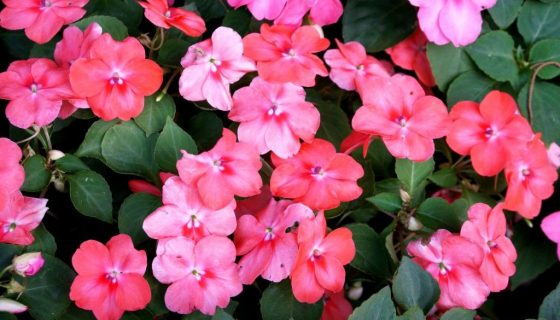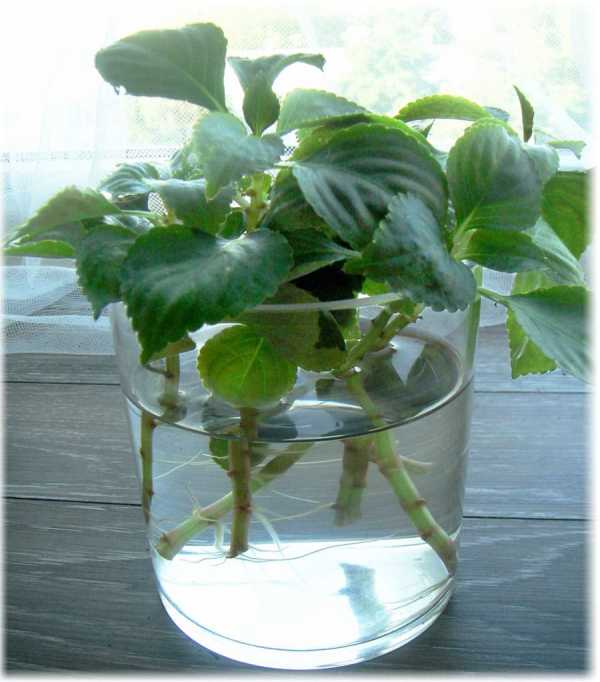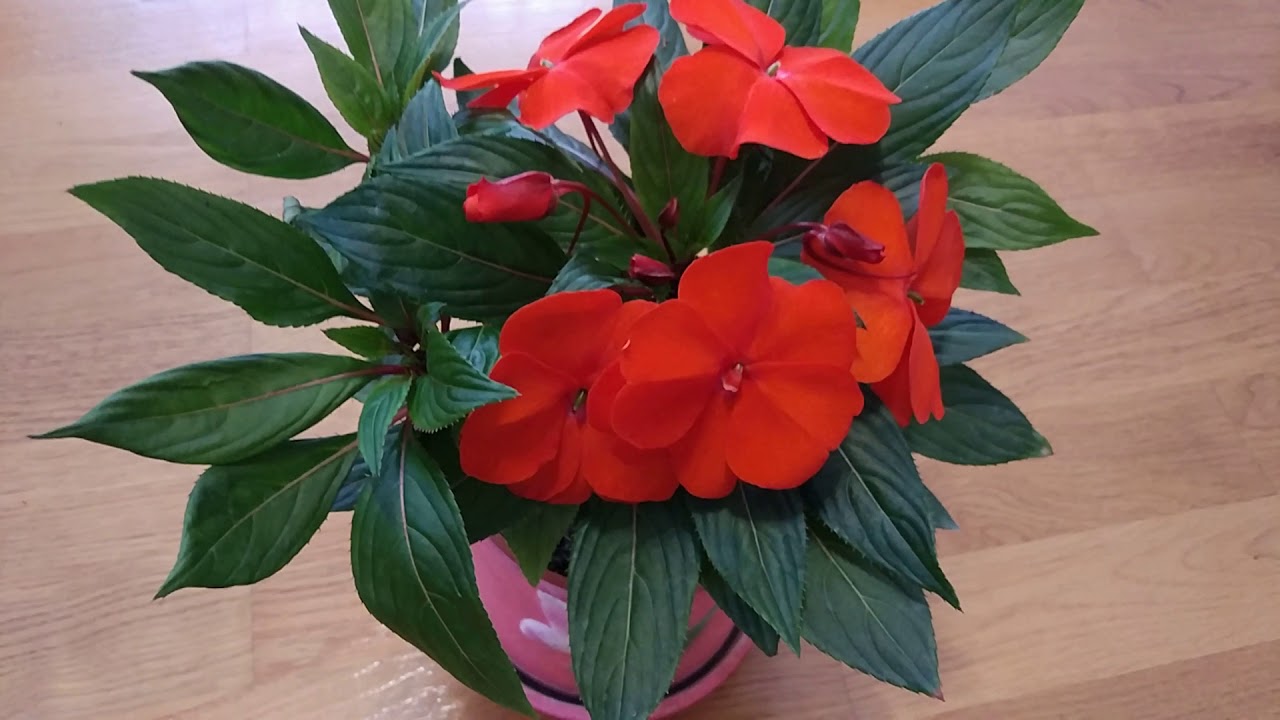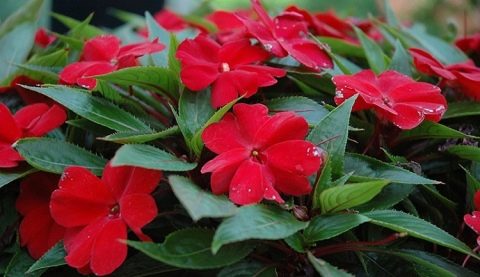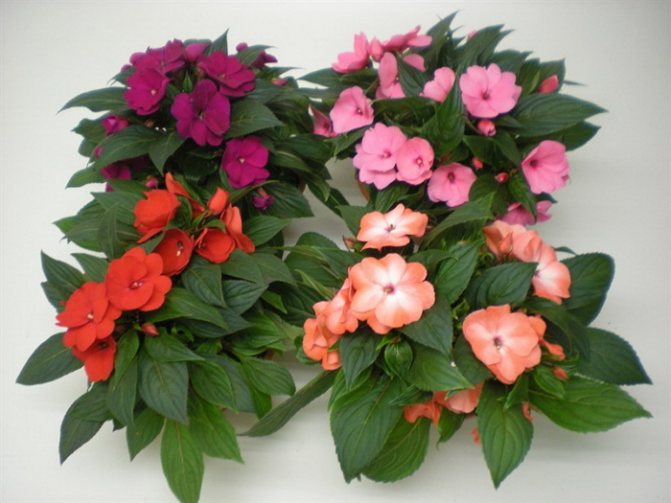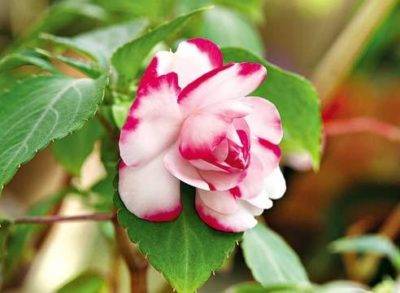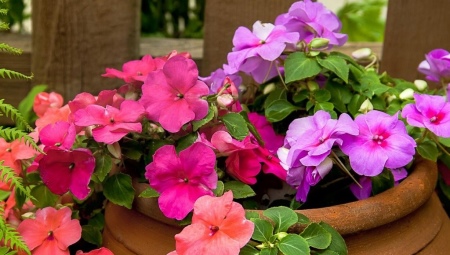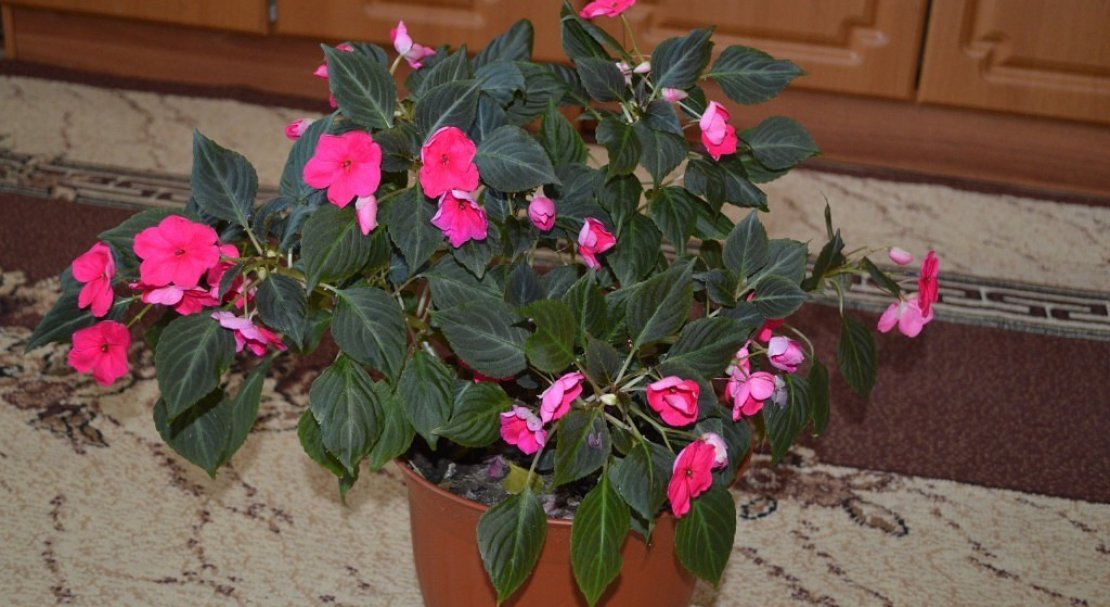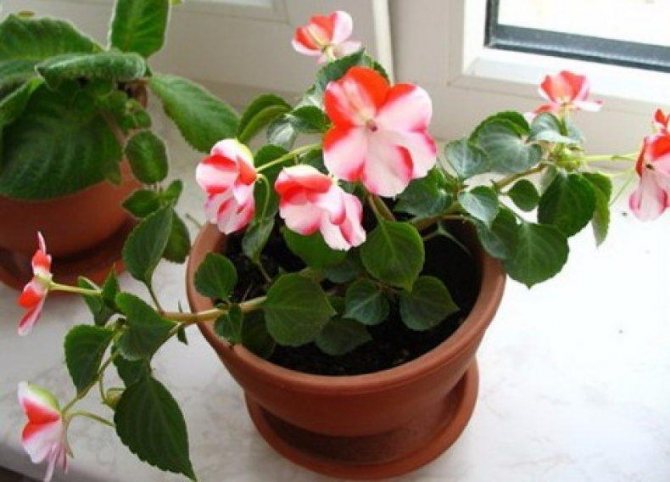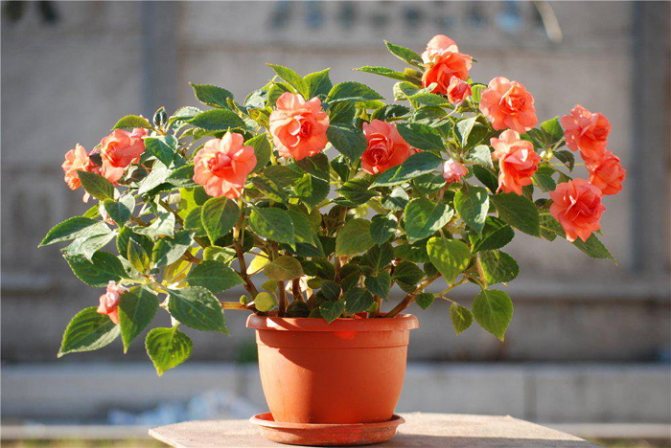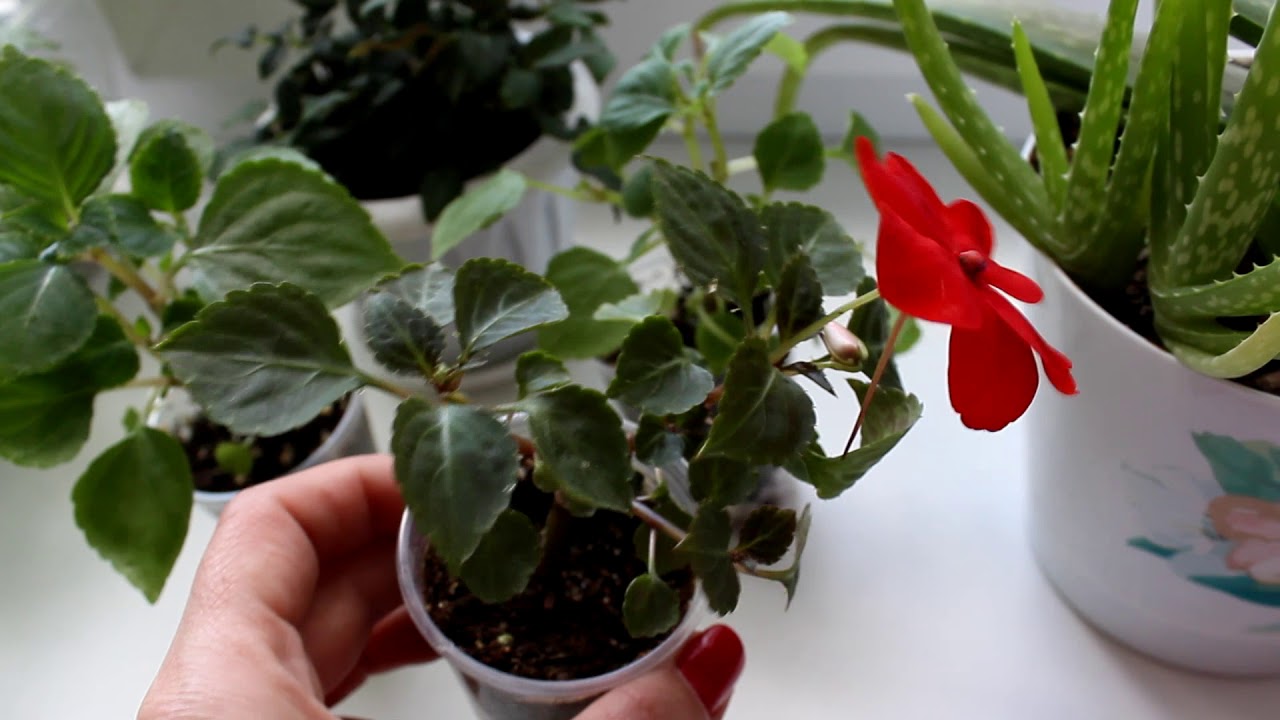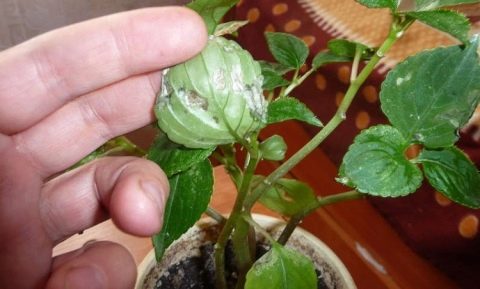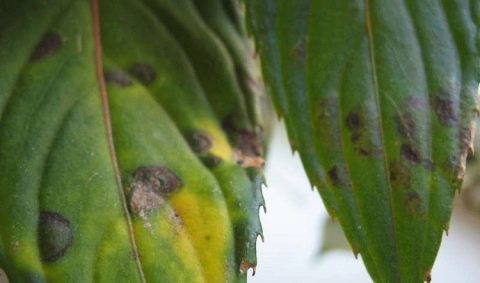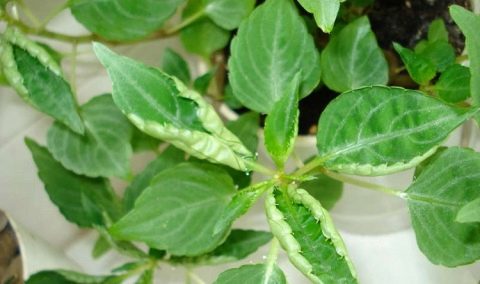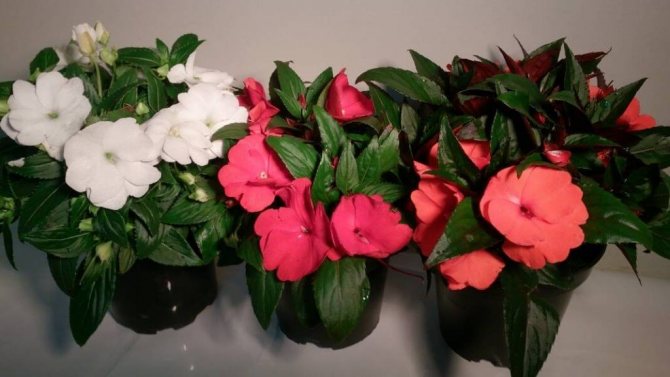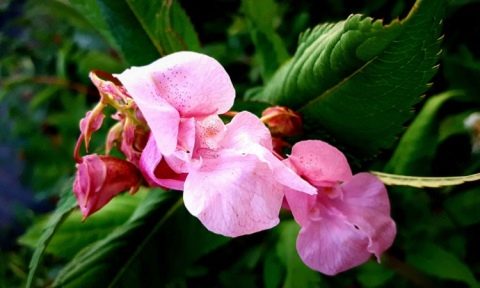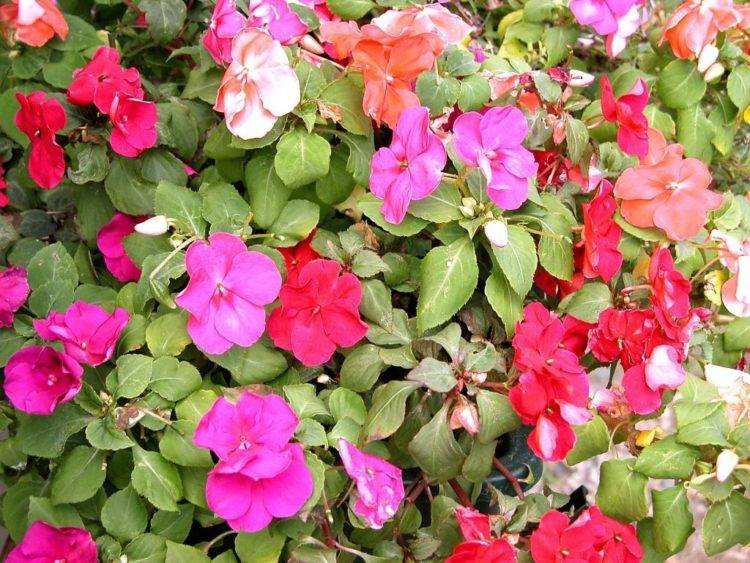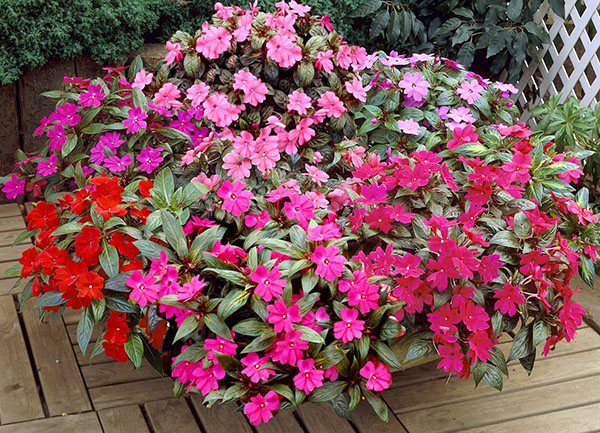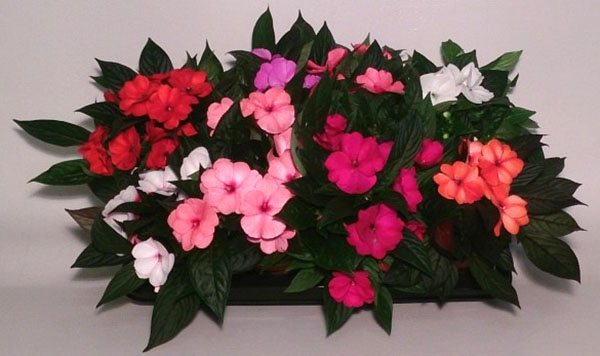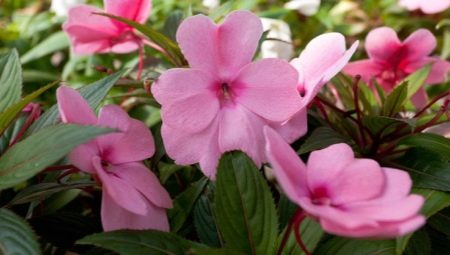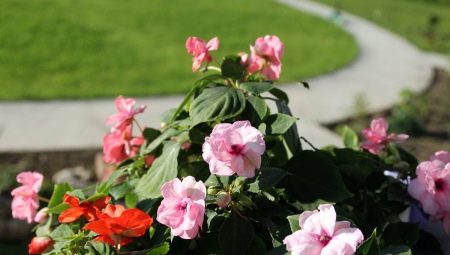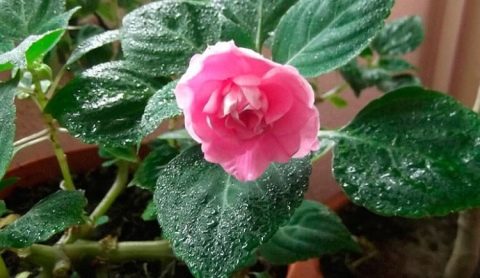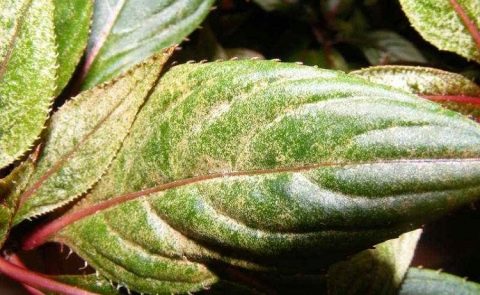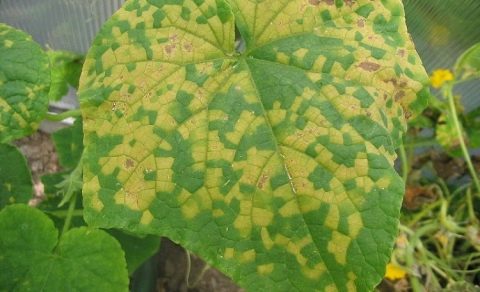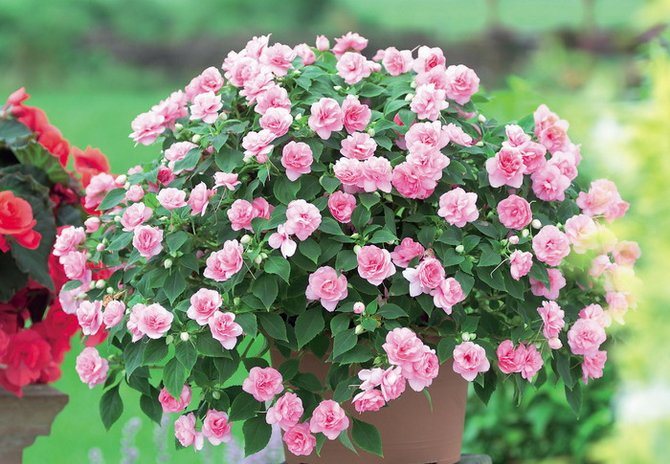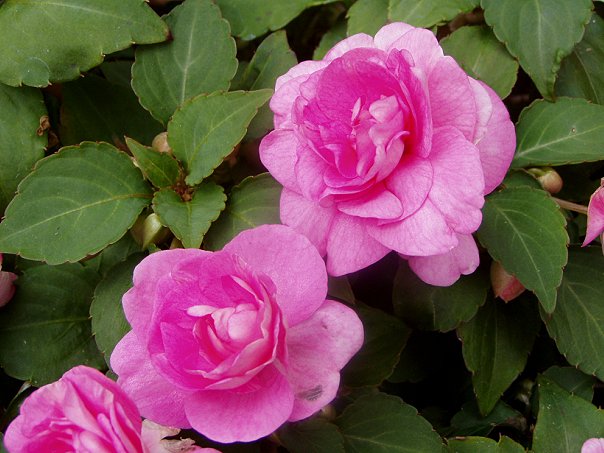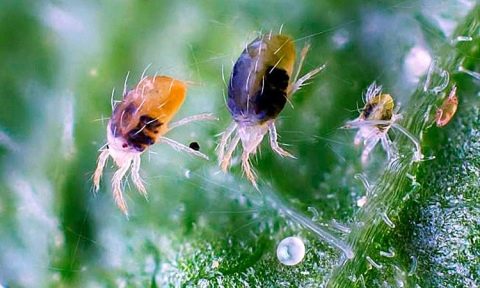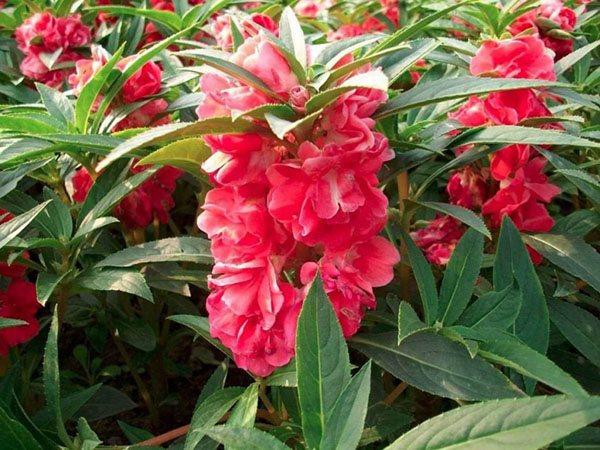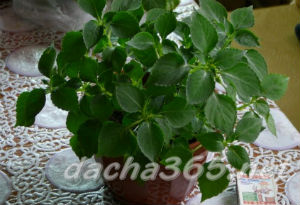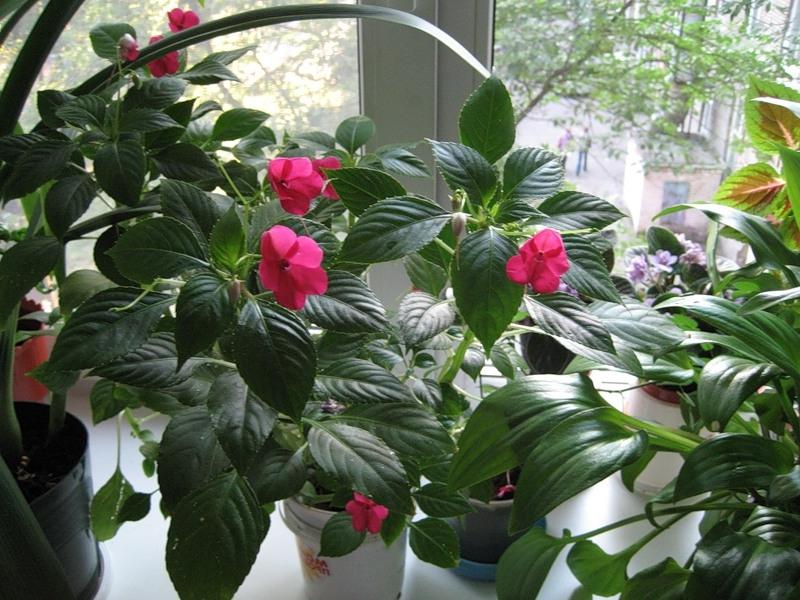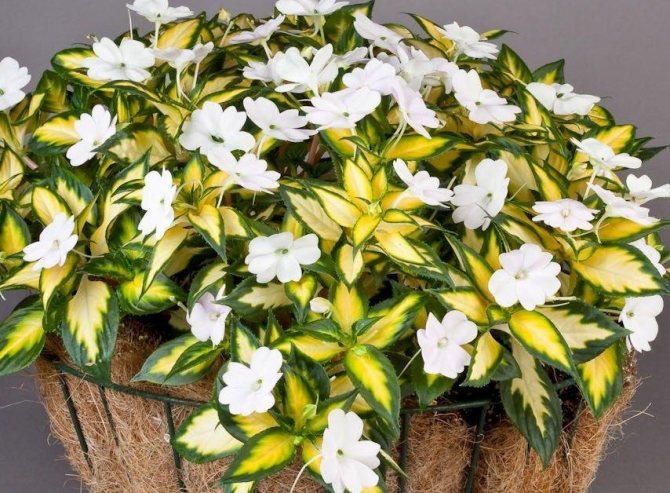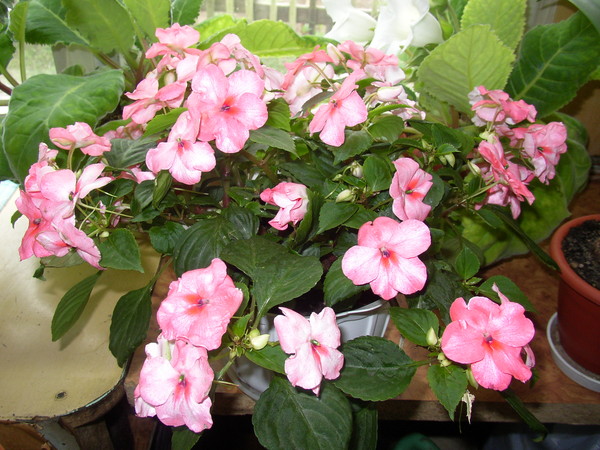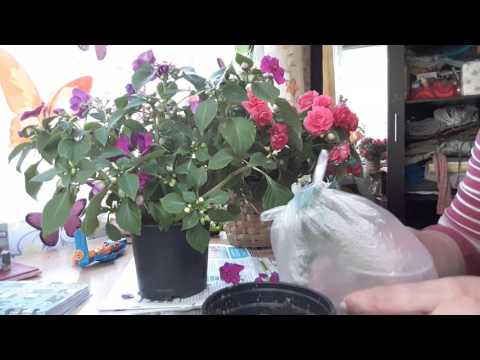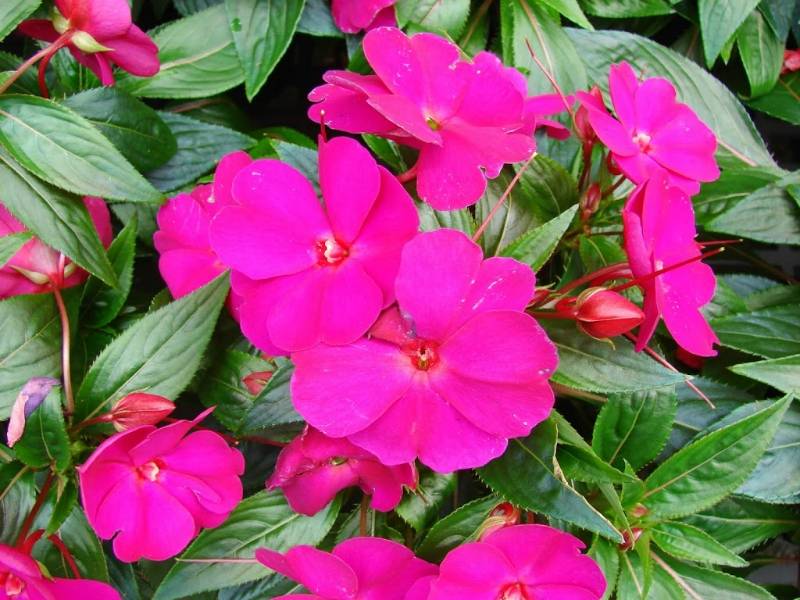Mistakes when caring for a beautiful indoor flower
Actions that lead to an increase in pest activity:
- the use of organic fertilizers, this contributes to the wilting of flowers, leaves;
- too frequent watering: it is recommended to water the balsam in winter no more than 2 times a week, and in summer - every other day;
- rare watering is also harmful: when the soil dries out, the flower weakens;
- the temperature is low or, conversely, high, it is recommended to maintain this indicator at + 18 ... + 22 ° С;
- when the balsam develops, you need to feed it 1 time every 10 days, it should not be done too often, the flower may die, as it does not tolerate excess nutrients;
- dense installation of pots on the windowsill;
- water is not removed from the pan, which contributes to waterlogging of the soil and root system;
- the leaves of the flower are not sprayed (this should be done daily).
Advantages and disadvantages
The advantages of this flower include:
- Unpretentious care, it is enough just to water moderately and regularly.
- Fast, easy rooting of cuttings in water.
- Earlier flowering, and up to 7-8 months in a row, the duration of abundant flowering without transplants - up to 3 years.
- Variety of colors.
- Abundance of bushes with proper care.
- A smart look that can beautify the interior of any room.
- Decorative leaves with various colors: purple, light green, black, bright light.
- Growth of beautiful flowers in the form of roses.
- Planting plants not only in the apartment, but also in the garden, in flower beds, containers.
Among the disadvantages are:
- The instability of the plant to the onslaught of all sorts of pests, death from the invasion of ticks, whiteflies.
- The need to treat wet vanka with preparations from pests at least 2-3 times a year.
- Inability to coexist with other plants. They need to be placed farther away, otherwise the wet vanka will begin to shed the foliage.
Biological impact
For every predator, there is a more terrible predator. So, for the spider mite, the phytoseiulus bug is considered the enemy. Artificial colonization of plants with these insects allows you to destroy the parasite with someone else's, so to speak, teeth. Disadvantage: this method can only be used in greenhouses.
To combat the tick, biological products have been created: "Akarin", "Bitoxibacillin", "Fitoverm". How to use them correctly?
- "Akarin" is diluted in a proportion of 2 ml of the drug per liter of water.
- "Bitoxibacillin" - 80-100 g per 10 liters of water. The disadvantage of this drug is that it can cause allergies if it comes into contact with treated plants.
Both solutions are used throughout the growing season every 15 -17 days.
Fitoverm is diluted in the amount of 10 ml per 10 liters of water. Processing is carried out every 7-10 or 14-20 days. The processing period depends on the age and size of the plant.
The pesticides clofentesin and flufensin are hormonal. They do not destroy all individuals at once, but sterilize the uterus. The effect of their use is long-term, but becomes noticeable after a few days. Some individuals die out, while others do not appear. If you need to destroy the tick urgently, you can mix this drug with any of the biological products.
Reproduction
Wet breeding is possible at any time of the year. The cuttings are cut below the nodes with the removal of the lower leaves and the weak top.
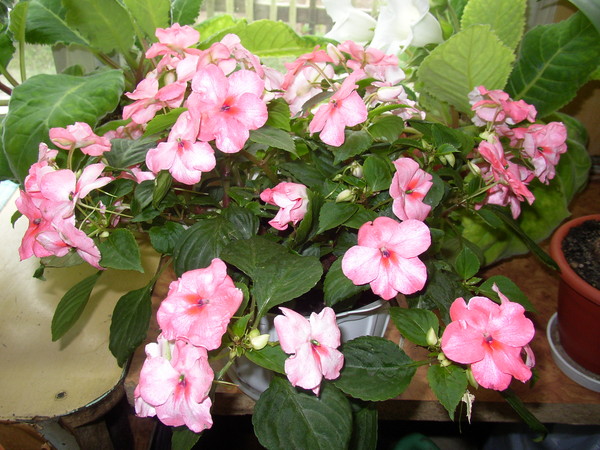
Vanka propagates by cuttings. For planting young seedlings, the substrate should be light enough.In order for the plant to take root faster, the bowls are placed in a dark place for a couple of weeks.
Planting is carried out with a length of 5-6 cm in soil fertilized with peat and sand. It is possible to place several roots in one pot at once, so the flowering of the bush will be more magnificent.
You can propagate Vanka by seeds in the spring by planting 2-3 seeds in a pot, previously treated with a weak solution of potassium permanganate (1%).
Balsam pests
Spider mite
Signs of the appearance of a spider mite are yellow specks on the surface of the leaves. If you do not engage in treatment, then these specks will develop into large spots that will be discolored and dry.
Spider mites are small insects that live on the inner surface of leaves.
Typically, the appearance of a spider mite is caused by dry air and elevated temperatures in the room. Therefore, for prevention, constantly spray the plant with water.
To avoid the spread of the pest, the affected parts of the flower must be removed. If the lesions are still mild, you can rinse the leaves with soapy water or mineral oil.
If the disease is already strong enough, the leaves must be treated with "fitoverm", "acarin", "vertimek", "lightning" or other drugs.
Whitefly
Whitefly is a small insect, two to three millimeters in size with white wings, insect larvae are also white and they do the most harm.
The disease can be noticed by the yellowing of the leaves and the presence of specific sticky secretions on them, you can also see insects on the inner and outer sides of the leaves.
To resist the whitefly, the leaves are treated with special agents based on potassium soap or other preparations: Aktellik, Iskra, Biotlin, Tanrek, Bison, Karbofos, Inta-Vir and others.
Multi-claw mites
Claw mites are small, transparent white insects, about a third of a millimeter in size.
Symptoms of the appearance of multi-claw mites are hardening and curvature of the leaves. They practically do not grow and begin to curl around the edges.
The reason for the occurrence of mites of different claws is the increased temperature and humidity in the room.
To prevent the occurrence of mites, the plant should be checked regularly.
If balsam is already infected, use such drugs for its treatment as: "fitoverm", "lightning", "vertimek", "acarin".
Thrips
The signs of this disease are the deformation of young leaves, since their growth point is bent under the influence of thrips. Also, the signs of their appearance are the appearance of spots on the flowers and the browning of the petals along the edges.
Thrips actively appear in the area of flower stamens and are carriers of leaf bronzing.
In order to control thrips, the infected leaves and flowers must be removed immediately. It is especially worthwhile to carefully monitor young plants, because even from short-term contact with pests, they can forever be spoiled.
It is necessary to treat a flower from thrips with such preparations as "Aktara", "Fufanon", "Actellik", "Iskra", "Tanarek" and others.
It is necessary to use special preparations in a course of several procedures with a difference of 4-5 days, since insecticides may not affect all periods of insect development.
Plant Brief
Balsam is a perennial crop with an erect stem and fleshy toothed foliage. The maximum height of the bush is 50 cm, the length of the leaf is 8-12 cm. The inflorescences are in the axils of the plant, their shade is varied (from delicate pink to deep red).
Balsam hybrids have double flowers. After the end of the flowering period, a fruit is formed - an elongated box, which consists of 5 twisted leaves.
On a note! At the slightest touch to the box, it opens and seeds are fired from it with force.For this property, the plant is called Impatient.
Long flowering explains another name for balsam - Ogonyok. In different countries, this species also has different designations: Zealous Lisa in Germany, Vanka-wet in Russia.
Common diseases of balsam and their treatment
One of the main signs indicating that "Vanka is wet" requires the help of a grower is a change in the appearance of the plant. Strange staining, dropping, discoloration or wilting of leaves are the most common signals that indicate a problem. In most cases, the cause of the development of diseases or damage to balsam by pests is improper care.
When the conditions of keeping the plants are violated, immunity begins to rapidly decrease, ensuring their resistance to parasites and pathogens. Some diseases are detrimental to balsams.
Given this fact, it is important to take all the necessary measures in time, barely noticing that the flower has acquired a painful appearance.
Bacteriosis
The fact that the plant has become a victim of a dangerous disease - bacteriosis, is evidenced by the formation of gray-brown spots on its leaves. As the disease progresses, traces of the lesion turn black-brown. Among the main causes of bacteriosis, flower growers call an excess of moisture in the soil. In addition, it is possible to infect balsam with bacteriosis pathogens through infected (low-quality) soil or untreated instrumentation. This disease is very dangerous, since most often the plant affected by it dies rather quickly.
In most cases, diseased flowers must be destroyed. However, you can try to compete for your green pet as follows:
- remove all affected parts of the plant;
- thoroughly spray the bush and soil in the pot with a solution of copper oxychloride (4 grams of substance per 10 liters of water);
- repeat treatment after 2 weeks.
Important! During treatment, the plant must be isolated from healthy flowers. Given that this disease is highly contagious, the risk of its spread throughout the green collection is very high.
Powdery mildew
The fact that the plant has suffered from powdery mildew is indicated by specific whitish spots that form on the leaves. If you do not start treating the disease in a timely manner, very soon the affected leaves will fade and fall off. The main causes of this disease are violations of the temperature and humidity regime, incorrect watering and lack of lighting. The powdery mildew treatment complex provides for such measures as:
- removal of the affected parts;
- treatment of the bush with a soap and soda solution (1 tablespoon of soda ash, 2 tablespoons of soap, 5 liters of warm water); the treatment of the plant is carried out using a spray for indoor flowers;
- after 1.5–2 weeks, the procedure is repeated.
Mosaic
Mosaic is one of the most dangerous diseases that lead to the death of balsams. The specific symptoms of this disease are the formation of yellowish spots and deformation of the foliage. As the disease progresses, the tissue of the affected leaf plates undergoes necrosis, as a result of which the plant gradually turns yellow and eventually dries up completely. The main carrier of the causative agents of this disease are thrips - tiny parasites that live in the soil.
Since there are currently no effective treatments for this disease, diseased plants are usually destroyed.
Rot
Failure to follow the recommendations for caring for plants often becomes the cause of the development of an insidious fungal disease - gray rot. With this problem, dirty brown spots begin to form on the foliage of the affected balsams. Novice flower growers are often faced with the development of rot on balsams as a result of watering with cold water, as well as due to too low room temperature.To preserve the plant, you need to adhere to the following actions:
- remove all infected parts of it - leaves and stems covered with spots, in this case they are cut off with a sharp disinfected blade, after which they are destroyed;
- after the procedure, the diseased bush is thoroughly treated with fungicidal preparations ("Fundazol");
- to make the treatment more effective, you can sprinkle the plants with products prepared according to folk recipes, for example, an infusion of dry garlic or onion peels.
Balsam diseases and their treatment
At low temperatures, the need for moisture decreases, so watering must be reduced. If this is not done, you cannot avoid the appearance of rot, others, as in the photo, diseases and pests of balsam.
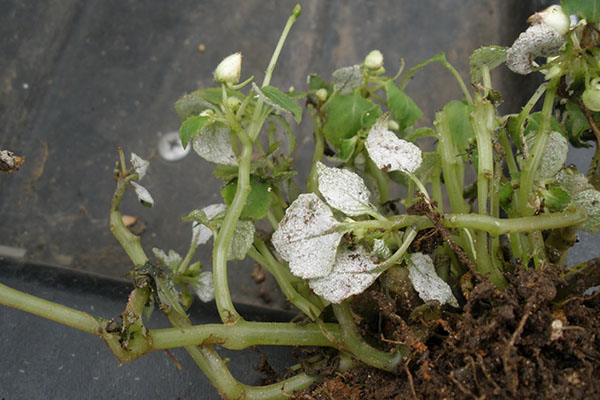 Among the diseases of balsam, the greatest harm to plants outdoors is caused by downy mildew.
Among the diseases of balsam, the greatest harm to plants outdoors is caused by downy mildew.
Several years ago, a real epidemic of this disease hit the balsams in the United States. The development of the infection was facilitated by:
cool wet weather;
crowded plantings, in which moisture does not have time to evaporate from the soil surface;
insufficient attention to plant care.
The first signs of disease caused by harmful fungi appear at temperatures below 16-18 ° C at 100% humidity. The causative agents of the disease with moisture permeate the tissue of the leaves, and after a couple of days a healthy balsam flower is transformed. First, a whitish bloom appears on the back of the leaves, then they turn black and fall off.
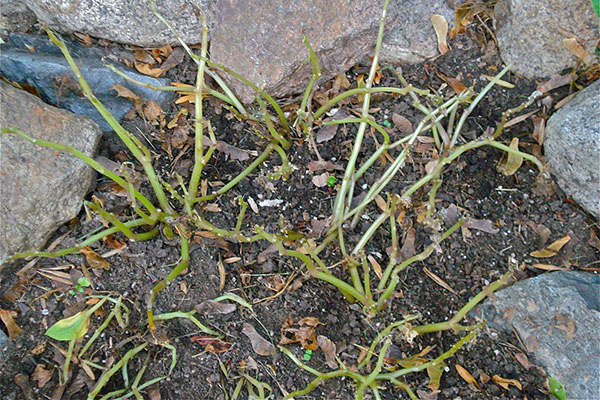 New foliage becomes shallower, or growth stops altogether. As a result, only non-viable remnants of shoots remain from the flowering balsam. In order to prevent the death of plants, during a cold snap:
New foliage becomes shallower, or growth stops altogether. As a result, only non-viable remnants of shoots remain from the flowering balsam. In order to prevent the death of plants, during a cold snap:
- reduce the frequency of watering;
- protect balsams from falling out of cold dew;
- take measures to ventilate the room.
At the first signs of the disease, all balsams affected by the disease are removed, and the plants are treated with systemic fungicides without visible damage.
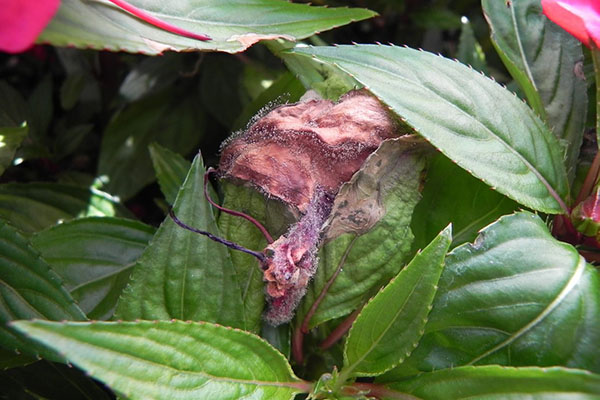 Balsams, forced to grow in excessively moist soil, often become victims of putrefactive bacteria.
Balsams, forced to grow in excessively moist soil, often become victims of putrefactive bacteria.
An additional factor contributing to the spread of dangerous fungi and microorganisms is the lowered air temperature. In such conditions, plants need less moisture, their metabolic processes and growth slow down.
Rot affects the stems in contact with the ground, as well as leaves and other parts of the plant. Infected shoot or leaf stalk turns brown, thinner and dies
The greatest attention should be paid to balsam disease and its treatment if traces of gili are found on young specimens and only seedlings that have given roots.
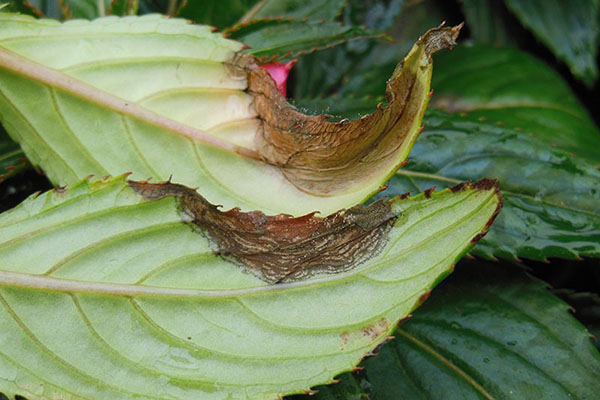 As a preventive measure, cuttings prepared for rooting must be treated with a systemic fungicide, then re-treatment is carried out already at planting, not forgetting to well irrigate the soil at the base of the stem with the agent.
As a preventive measure, cuttings prepared for rooting must be treated with a systemic fungicide, then re-treatment is carried out already at planting, not forgetting to well irrigate the soil at the base of the stem with the agent.
Typical properties of a houseplant
Balsam is a very interesting plant that has its own characteristics.
They are as follows:
- The flower, originally from Africa, loves abundant lighting, but in hot weather it cannot stand direct sunlight. Balsam also takes root in partial shade, while flower bushes lose their splendor and do not form a profusely blooming crown.
- The tropical Impatiens is thermophilic. Acceptable temperature regime for its favorable development and growth is + 22 ° in summer, + 15 ° C in winter. Balsam does not tolerate too dry air in the room where it grows.
- "Vanka wet" is hygrophilous. Requires abundant watering in summer, moderate humidity in winter.
- During the active growth phase (from spring to autumn), the flower needs fertilizing with mineral and organic fertilizers.
- In the conditions of cultivation in Russia, balsam tends to bloom for more than six months. If the lighting process and the temperature regime in the winter are properly organized, then the plant can delight with flowers all year round.
- The potting soil mixture, in which the balsam is comfortable to take root, consists of sand, turf, humus, peat and leafy soil in a ratio of 2/2/2/1/2.
Treatment
At low temperatures, the need for moisture decreases, so watering must be reduced. If this is not done, you cannot avoid the appearance of rot, others, as in the photo, diseases and pests of balsam.
Among the diseases of balsam, the greatest harm to plants outdoors is caused by downy mildew.
Several years ago, a real epidemic of this disease hit the balsams in the United States. The development of the infection was facilitated by:
cool wet weather; crowded plantings, in which moisture does not have time to evaporate from the soil surface; insufficient attention to plant care. New foliage is shrinking, or growth stops altogether
As a result, only non-viable remnants of shoots remain from the flowering balsam. In order to prevent the death of plants, during a cold snap:
New foliage becomes shallower, or growth stops altogether. As a result, only non-viable remnants of shoots remain from the flowering balsam. In order to prevent the death of plants, during a cold snap:
- reduce the frequency of watering;
- protect balsams from falling out of cold dew;
- take measures to ventilate the room.
At the first signs of the disease, all balsams affected by the disease are removed, and the plants are treated with systemic fungicides without visible damage.
Balsams, forced to grow in excessively moist soil, often become victims of putrefactive bacteria.
Rot affects the stems in contact with the ground, as well as leaves and other parts of the plant. Infected shoot or leaf stalk turns brown, thinner and dies
The greatest attention should be paid to balsam disease and its treatment if traces of gili are found on young specimens and only seedlings that have given roots.
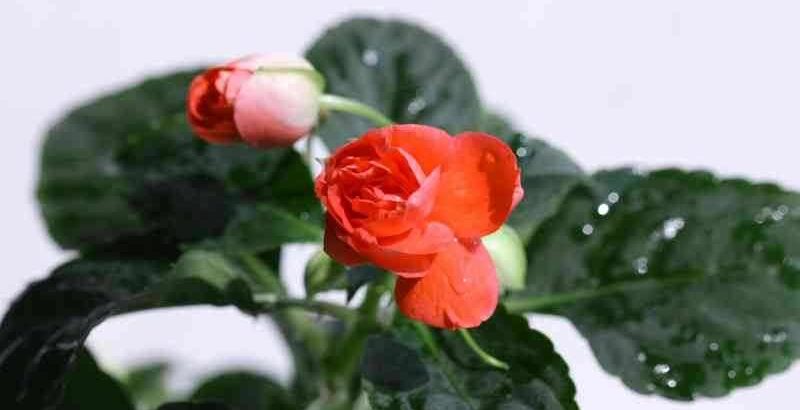
How to cure flowers from spider mites? If a tick is found, the plant must first be thoroughly washed with laundry or tar soap. Lather each leaf and each bosom, whipping the foam with your hands and gently processing all parts of the plant. Leave the flower for several hours (you can even for a day), covering it with a plastic bag. Then rinse off the soap thoroughly under a warm shower.
If the lesion was insignificant, then such a procedure will be sufficient, however, it must be repeated two or three times during the week. The plant should be sprayed with warm water twice a day and inspected regularly.
Wash frames and windowsill with hot water and any detergent. The rest of the plants on the windowsill also need to be treated for prevention purposes. Spider mites do not tolerate fresh air and ventilation.
What if the defeat has gone far enough? It is necessary to first carry out the treatment with soap, then spray with the preparations "Intavir", "Fitoverma", "Karbofos". When processing a window, it is also worth adding "Karbofos" to the water.
Sometimes a fairly simple method helps: an open container with finely chopped garlic or turpentine is placed near the plant, the plant is tightly closed together with the container for 2-3 days. The edges of the pot must be greased with tar.
Fighting spider mites with folk remedies
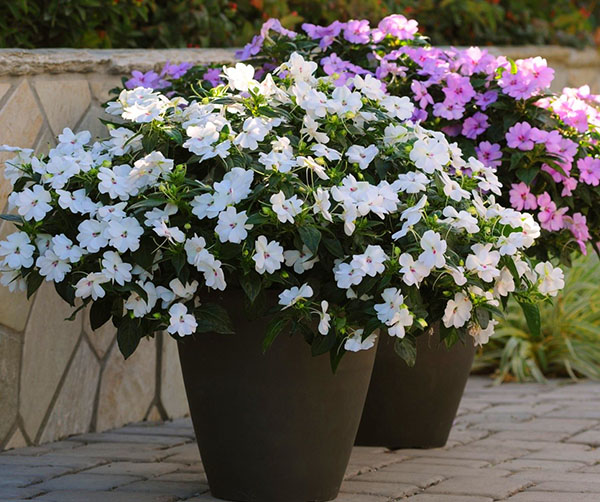
For an indoor green corner, a tick is no less dangerous enemy than for a vegetable garden. As well as in the beds, in flowerpots, the parasite infects almost all species. The "almost" category includes saintpaulias, streptocarpus, herseniae, uzumbar violets. In contrast, dracaena, dieffenbachia, indoor roses, arrowroot, citrus, balsam are a favorite delicacy of the tick.
If this attack starts in the apartment, disinfect the entire window sill, preventive treatment of healthy plants. In some cases, you may have to sacrifice one, the sickest flower in order to save the rest. Ticks spread very quickly and hide well under adverse conditions.
Methods, proven by popular experience, have an effect no worse than industrial drugs. In any case, they will not harm either man or animal. Ingredients for solutions are the simplest and most affordable. Not only indoor plants, but also the inhabitants of the beds, especially cucumbers, are subject to processing with folk remedies.
At the first sign of illness, give the plant a cold shower every day. This is suitable for those species that do not mind this procedure. You can use laundry soap or dishwashing detergent - wash the leaves, stems, pot, windowsill well. Chop approximately 150 g of peeled garlic in any way, add 1 liter of water and leave for 5-7 hours. Dilute the resulting concentrate in a ratio of 5 ml / 1 l of water, use for processing plants. Like garlic, onion infusion is prepared, only it is used without dilution. Cloves of garlic, pieces of onion can be put in a pot if the houseplant does not like spraying. Cover the pot with a plastic bag. An infusion is prepared from the roots of medicinal dandelion: 20 g of roots per 1 liter of water. Take warm water. You can use it in a couple of hours. You can treat infected areas of hard-leaved plants with a swab dipped in rubbing alcohol.
This must be done carefully and quickly so as not to burn the leaves.
- Cyclamen. Boil several tubers of this plant for 40 minutes. In a day, the broth is ready for use.
- Yarrow. Pour a kilogram of dried herbs with a bucket of boiling water. After 3-4 days, add 3 tbsp. To the strained infusion. tablespoons of grated laundry soap.
- Tar soap. Proportion: 10 g per liter of water.
- Turpentine. A jar of turpentine is placed near the affected houseplant and covered with a plastic bag together for several hours.
Briefly about the plant
Annual and perennial flowering plants from the Asteraceae family are called "marigolds" in Russia. The scientific name is tagetes. Flowers appeared in Europe in the 16th century, arriving in the Old World from America on the ships of the conquistadors. Over the centuries of work, breeders have bred about 60 varieties and hybrids of marigolds. Long flowering and unpretentiousness of the plant made it popular among gardeners. You can find out more about the varieties of marigolds, as well as see the description and photos of flowers here, and about the features of caring for a stunted species, read here.
Marigolds are bushes with an erect stem, pinnately dissected leaves of various shades of green and bright inflorescences. The height of the culture is from 20 to 100 cm.In decorative floriculture, 3 main types of tagetes are grown:
- rejected;
- upright;
- thin-leaved.
Learn how to properly grow Upright, Thin-leaved, Rejected species marigolds in the open field, and also you can see the photo of flowers here.
Bred marigold varieties with chrysanthemum, double and semi-double flowers. The color of the hybrids is white, yellow, orange, red or two-color.
Information. Some varieties of marigolds are used in cooking and medicine.
Parasites: diagnosis, causes and actions
Balsam is most often affected by ticks - these are annoying small parasites that suck all the juice from the stem. Aphids, thrips and whiteflies are also dangerous to the plant.
Tick infestation
Typical signs can be seen when examining the reverse side of the leaf or internodes. Symptoms of spider mite infection are the thinnest white film and small dots on the foliage, their loss of shine, and a decrease in flowering intensity. The reasons for the appearance are high room temperature and low humidity levels. How to deal with balsam spider mites?
- Trimming the affected parts.
- Treatment of the bush with soapy water (it is preferable to dilute tar soap in water). Apply the foam to the plant, rinse off after 5-10 minutes. Repeat the procedure after 7 days.
- With a high degree of infection, chemical treatment is required.Fitoverm and Vertimek are on their list. Select the dosage according to the instructions.
The cyclamen mite can also parasitize on balsam. It deforms young leaves, lateral buds and shoots. The plant loses its points of growth and dies quickly. You can get rid of the pest only when treated with acaricides.
Aphid
The insect sucks the juice from the leaves, then their deformation and growth arrest occurs. With a high degree of damage, the process of photosynthesis is impossible, as a result, the balsam stops developing normally and dies.
It is quite difficult to notice the infection on the bush, but the nests of aphids from a whitish bloom are clearly visible on the walls of the pot.
Important! The reason for the development is improper care and irregular watering (the pest multiplies in dry soil).
You can identify aphids when transplanting or examining the root system. Folk methods of struggle - tinctures of tobacco leaves, onion husks and wormwood. Also, an infected bush can be treated with ash, tobacco dust, or a mixture of ash and soap.
How to deal with aphids? Chemicals for salvaging balsam - Fas, Decis, Actellik. Dosage and application characteristics depend on the size of the plant (use according to the instructions). When processing with chemicals, the soil in the pot must be covered with foil.
Detailed algorithm of actions:
- Removal of damaged and dried fragments.
- Treatment of cut parts with insecticides. Spraying the bush with a solution of dried tobacco and tansy herb.
- In the pot, completely change the soil, disinfect the pot itself.
Whitefly
In appearance, the insect resembles a small white moth. The breeding period (from laying eggs to hatching of an individual) is 35-40 days.
The whitefly lays eggs on the back of the leaf, later larvae appear from these eggs, which eat the entire balsam bush.
Over time, the skin of the larvae hardens, and individuals become invulnerable to certain chemicals. Therefore, the plant must be processed several times, observing a break of 4-6 days.
Symptoms of infection - foliage loses its green color, yellow spots appear on it, later it dries up and falls off. A dangerous consequence is the complete death of the plant.
Reference. The whitefly also secretes a sugary liquid that contains the pathogens of the sooty fungus.
How to kill a whitefly?
Regular shower. Eggs and larvae can be flushed away with water
It is important to process both sides of the sheet.
Removal of the affected parts of the bush.
Destruction of individuals with insecticides. Florists recommend using Karbofos, Tanrek, Actellik
These are poisonous drugs that are forbidden to be sprayed in the apartment. You need to carry out the procedure on the balcony or on the street.
An alternative to chemicals is home remedies. You can process balsam with grated garlic tincture. For cooking, you need to grind 1-2 cloves, turn them into gruel. Pour boiling water over and leave for up to 3 hours. Use for spraying 2 times a day.
Thrips
Insects carry a double threat: they weaken the bush, being a pest, and also carry the mosaic virus - a dangerous disease of indoor balsam. The problem can be diagnosed by the deformation of young leaves at the top and a change in the growth point.
The greater the impact of pests, the worse the appearance of the flowers. The edges begin to dry, and live insects can be seen in the center of the corolla.
The main method of dealing with them is the removal of infected fragments and subsequent treatment with insecticides.
It is important to isolate the affected bush from the rest. You need to spray the plant with Tanrek or Aktellik
Tanrek must be diluted in a proportion of 1 ml per 5 l or 2 ml per 10 l (it is necessary to measure the drug with a syringe). Dosage of Actellik for severe infection: 1 ampoule per 1 liter of water. The spraying procedure should be repeated after 5-7 days.
If the plant dries
First of all, you should examine it for the presence of a spider mite.If the parasite is present, then the reason is in it.
What should be done:
- Trim flowers to reduce stress.
- Lather the sponge with laundry soap and wipe the plant. You should also wipe the pot and tray.
- Rinse off the soap thoroughly with running water from the shower.
- After drying, spray the plant with Fitoverim (insectoacaricide with intestinal action). To prepare the solution, dissolve 5 g of the drug in 1 liter of water. Spray the flower with a spray bottle. Repeat the procedure after 10 days.
The spider mite is a parasite that feeds on plant cell sap. As a result, they become weak and susceptible to infections.
If there is no spider mite, then the reasons may be as follows:
- Dry air. In order to solve the problem, you need to spray the flower twice a day.
- Air temperature. It should not drop below 15 degrees.
- Direct sunlight. In the beginning, burns appear, then the flower dries up.
- Soil quality. If the soil has not been changed for over a year, it depletes. The flower lacks nutrients.
- Decay of roots. Reasons: excessive watering, soil contamination with fungal infections.
- Insufficient watering. The plant suffers from a lack of moisture.
Reasons for the death of a flower:
- Diseases of a fungal, viral and bacterial nature.
- Pests. Thrips, whitefly, spider mites, aphids.
- Improper care: excessive watering (provokes root rot), insufficient watering, low temperature combined with high humidity.
Diseases of balsam
Balsam is not a capricious flower and is not so often exposed to diseases. But there are some diseases and pests that can lead to death, although in the early stages most of these diseases are treatable.
The main thing is not to waste time, otherwise the plant will die, you need to pay attention to the symptoms that appear
Falling foliage
Balsam leaves fall for several reasons:
- Hypothermia and insufficient light. It is advisable to transfer the pot to a brighter and warmer place.
- Irregular watering can cause foliage to fall off Vanka wet. Do not allow the soil to dry out, as this leads to curling, yellowing and drying of the foliage.
- But excessive watering is harmful and can also cause the death of leaves. In summer it is worth watering more often, in autumn and winter - once every 3 days. The soil is ideally moist, but not wet, the water in the pot should not stand.
- The appearance of a white coating on the leaves, loss of gloss, wilting and eventually dropping means the appearance of a spider mite. It is worth fighting the pest with the help of insecticides.
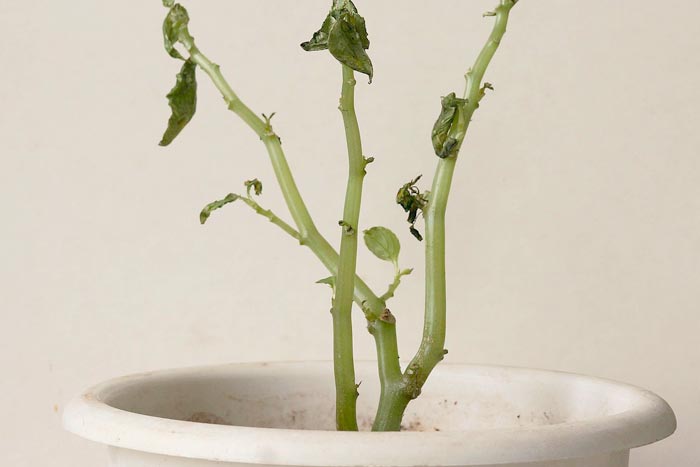
Curling and yellowing of foliage
In balsam, leaves curl as a result of an attack of ticks (arachnoid or multi-claw). For treatment, the affected areas are removed and the plant is treated with a special pest remedy.
Leaves turn yellow most often due to lack of moisture. In this case, the frequency of watering is adjusted.
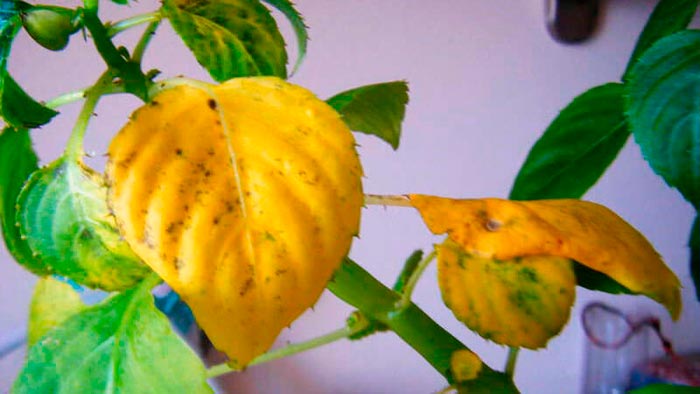
Lack of flowering
Why isn't the balsam blooming or the bloom suddenly stopped? This may be due to the improper maintenance of the plant: the flower lacks useful nutrients, light, moisture, heat. To remedy the situation, it is transferred to a sunny and warm place, fertilizing is carried out.
Falling buds
Balsam's buds fall off when the soil dries out or waterlogged. This can also occur during adaptation to a new place, for this reason, it is not recommended to disturb a plant with newly formed buds.
Gray rot
This is a fungal disease in which brown spots appear on the stems and leaves. If you do not take action in a timely manner, the plant will die. Causes of gray rot lesion:
- watering the flower with cold water;
- low air temperature and hypothermia;
- drafts;
- soil contamination with spores of pathogenic fungi.

Treatment of this disease is balsam: the affected areas are cut off, and the healthy ones are transplanted into a new pot with different soil and sprayed with Fundazol or garlic infusion.
Bacteriosis
The development of bacteriosis is indicated by the appearance of watery spots on the plant, which quickly increase, acquiring a brown color.
Causes:
- contaminated soil;
- using dirty tools;
- excess moisture or fertilizer in the soil.
Treatment: cut off all affected areas and spray with preparations containing copper.
Powdery mildew
With this disease, a white bloom appears on all parts of the plant, leaves curl and dry out.
The main reasons for the appearance of powdery mildew:
- improper watering;
- lack of heat and light;
- stagnant air.
Ways to combat: remove the diseased parts of the flower, and then spray it with a solution of soda ash.


